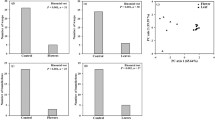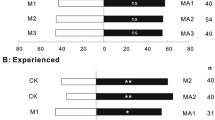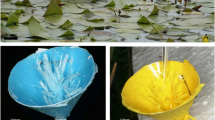Abstract
Plant volatiles influence virtually all forms of ant-plant symbioses. However, little is known about their role in the mutualistic relationship between the African weaver ant and the cashew tree. In this study, we tested the hypothesis that cashew tree volatiles from plant parts most vulnerable to herbivory viz. inflorescence, leaves, and fruits, are attractive to weaver ants. Using behavioral assays, we show that these volatiles attract weaver ants but without significant difference in preference for any of the odors. These same plant parts are associated with extra floral nectaries (EFNs’) and therefore we evaluated the possibility that the ants associate the volatiles with food rewards. We found that perception of the odors was followed by a searching response that led the ants to non-volatile sugar rewards. More importantly, we observed that weaver ants spent significantly more time around the odor when it was paired to a reward. Chemical analysis of volatiles showed that the plant parts shared similarities in chemical composition, dominated by monoterpenes and sesquiterpenes. Additionally, we evaluated the attractiveness of a synthetic blend of three ocimene isomers ((E)-β-ocimene, (Z)-β-ocimene and allo-ocimene) identified in cashew leaf odor and shown to constitute a candidate kairomone for the cashew pest Pseudotheraptus wayi. We found that the attractiveness of the blend was dose dependent, and the response of the ants was not significantly different to that established with the crude volatiles from plant tissues. These results present new and interesting possibilities for improving weaver ant performance in cashew pest management.








Similar content being viewed by others
References
Adams2 terpenoid/natural product library, Adams RP (1995) Identification of essential oil components by gas chromotography/mass spectrometry, Allured, Carol Stream
Agrawal AA, Dubin-Thaler BJ (1999) Induced responses to herbivory in the neotropical ant-plant association between Azteca ants and Cecropia trees: response of ants to potential inducing cues. Behav Ecol Sociobiol 45:47–54
Aldrich JR (1988) Chemical ecology of Heteroptera. Annu Rev Entomol 33:211–238
Arimura G, Kost C, Boland W (2005) Herbivore-induced, indirect plant defences. Biochim Biophys Acta 1734:91–111
Ayenor GK, Huis AV, Obeng-Ofori D, Padi B, Röling NG (2007) Facilitating the use of alternative capsid control methods towards sustainable production of organic cocoa in Ghana. Int J Trop Insect Sci 27:85–94
Bell WJ (1990) Searching behaviour patterns in insects. Annu Rev Entomol 35:447–467
Beugnon G, Déjean A (1992) Adapative properties of chemical trail system of the African weaver ant oecophylla longinoda Latreille (Hymenoptera, Formicidae, Forminicae). Ins Soc 39:341–346
Bitterman ME, Menzel R, Fietz A, Schäfer S (1983) Classical conditioning of proboscis extension in honeybees Apis mellifera. J Comp Physiol 97:107–119
Boucher D, James S, Keeler KH (1982) The ecology of mutualism. Annu Rev Ecol Syst 13:315–347
Brown ES (1955) Pseudotheraptus wayi, a new genus and species of Coreid (Hemiptera) injurious to coconuts in East Africa. Bull Entomol Res 46:221–240
Bruna EM, Lapola DM, Vasconcelos HL (2004) Interspecific variation in the defensive responses of obligate plant-ants: experimental tests and consequences for herbivory. Oecologia 138:558–565
Bruna EM, Darrigo MR, Pacheco AMF, Vasconcelos HL (2008) Interspecific variation in the defensive responses of ant mutualists to plant volatiles. Biol J Linn Soc 94:241–249
Cheng A, Lou Y, Mao Y, Lu S, Wang L, Chen X (2007) Plant terpenoids: Biosynthesis and ecological functions. J Integr Plant Biol 49:179–186
Crozier RH, Newey PS, Schlüns EA, Robson SKA (2010) A masterpiece of evolution – Oecophylla weaver ants (Hymenoptera : Formicidae). Myrmecol News 13:57–71
Dáttilo WFC, Izzo TJ, Inouye BD, Vasconcelos HL, Bruna EM (2009) Recognition of host plant volatiles by Pheidole minutula Mayr (Myrmicinae), an amazonian ant-plant specialist. Biotropica: 1–5
Dicke M, Sabelis MW, Takabayashi J, Bruin J, Maarten A (1990) Plant strategies of manipulating predator–prey interactions through allelochemicals: prospects for application in pest control. J Chem Ecol 16:3091–3118
Dudareva N, Pichersky E, Gershenzon J (2004) Biochemistry of plant volatiles 1. Plant Physiol 135:1893–1902
Dwomoh EA, Afun JVK, Ackonor JB, Agene VN (2008) Investigations on Oecophylla longinoda (Latreille) (Hymenoptera: Formicidae) as a biocontrol agent in the protection of cashew plantations. Pest Manag Sci 65:41–46
Edwards DP, Hassall M, Sutherland WJ, Yu DW (2006) Assembling a mutualism : ant symbionts locate their host plants by detecting volatile chemicals. Insect Soc 53:172–176
Egonyu JP, Ekesi S, Kabaru J, Irungu L, Torto B (2013) Cashew volatiles mediate short-range location responses in Pseudotheraptus wayi (Heteroptera : Coreidae). Environ Entomol 42:1400–1407
Farris SM, Schulmeister S (2011) Parasitoidism, not sociality, is associated with the evolution of elaborate mushroom bodies in the brains of hymenopteran insects. Proc R Soc B Biol Sci 278:940–951
Gammans N, Bullock JM, Gibbons H, Schönrogge K (2006) Reaction of mutualistic and granivorous ants to ulex elaiosome chemicals. J Chem Ecol 32:1935–1947
González-Teuber M, Silva Bueno JC, Heil M, Boland W (2012) Increased host investment in extrafloral nectar (EFN) improves the efficiency of a mutualistic defensive service. PLoS One 7:p.e46598
Gronenberg W (2008) Structure and function of ant (Hymenoptera: Formicidae) brains: strength in numbers. Myrmecol News 11:25–36
Guerrieri FJ, d’Ettorre P (2010) Associative learning in ants: conditioning of the maxilla-labium extension response in Camponotus aethiops. J Insect Physiol 56:88–92
Halitschke R, Stenberg JA, Kessler D, Kessler A, Baldwin IT (2008) Shared signals –‘alarm calls’ from plants increase apparency to herbivores and their enemies in nature. Ecol Lett 11:24–34
Hare JD (2011) Ecological role of volatiles produced by plants in response to damage by herbivorous insects. Annu Rev Entomol 56:161–180
Heil M (2008) Indirect defence via tritrophic interactions. New Phytol 178:41–61
Heil M (2010) Ant–plant mutualisms. eLS. doi:10.1002/9780470015902.a0022558
Heil M, McKey D (2003) Protective ant-plant interactions as model systems in ecological and evolutionary research. Annu Rev Ecol Evol Syst 34:425–553
Heinze J, Hölldobler B, Peeters C (1994) Conflict and co-operation in ant societies. Natur Wissenschaften 497:489–497
Hölldobler B, Wilson EO (1977) Colony-specific territorial pheromone in the African weaver ant Oecophylla longinoda (Latreille). Proc Natl Acad Sci U S A 74:2072–2075
Jersáková J, Johnson SD, Kindlmann P (2006) Mechanisms and evolution of deceptive pollination in orchids. Biol Rev Camb Philos Soc 81:219–235
Junker RR, Blüthgen N (2010) Floral scents repel facultative flower visitors, but attract obligate ones. Ann Bot 105:777–782
Koptur S, Truong N (1998) Facultative ant-plant interactions : nectar sugar preferences of introduced pest ant species in South Florida. Biotropica 30:179–189
Millar JG (2005) Pheromones of true bugs. Topics Curr Chem 240:37–84
Mithöfer A, Boland W (2012) Plant defense against herbivores: chemical aspects. Annu Rev Plant Biol 63:431–450
National Institutes of Standards and Technology (2005) NIST/EPA/NIH mass spectral library, http://www.nist.gov
Newey PS (2009) Colony-mate recognition in the weaver ant Oecophylla smargdina. Dissertation, James Cook University
Olotu IM, Plessis H, Seguni SZ, Maniania KN (2013) Efficacy of the African Weaver ant Oecophylla longinoda (Hymenoptera: Formicidae) in the control of Helopeltis spp (Hemiptera: Miridae) and Pseudotheraptus wayi (Hemiptera: Coreidae) in cashew crop in Tanzania. Pest Manag Sci 69:911–918
Perry CJ, Barron AB (2013) Neural mechanisms of reward in insects. Annu Rev Entomol 58:543–562
Pichersky E, Gershenzon J (2002) The formation and function of plant volatiles: perfumes for pollinator attraction and defense. Curr Opin Plant Biol 5:237–243
R Core Team (2012) R: A language and environment for statistical computing. R Foundation for Statistical Computing,Vienna, Austria. ISBN 3-900051-07-0, http://www.R-project.org/
Rickson RF, Rickson MM (1998) The Cashew nut, Anacardium occidentale (Anacardiaceae) and its perennial association with ants: extrafloral nectary location and the potential for ant defense. Am J Bot 85:835–849
Santos JC, Yamamoto M, Oliveira FR, Del-Claro K (2005) Behavioral repertory of the Weaver ant Camponotus (Myrmobrachys) senex (Hymenoptera: Formicidae). Sociobiology 45:1–12
Schiestl FP (2005) On the success of a swindle: pollination by deception in orchids. Die Naturwissenschaften 92:255–264
Schwander T, Rosset H, Chapuisat M (2005) Division of labour and worker size polymorphism in ant colonies: the impact of social and genetic factors. Behav Ecol Sociobiol 59:215–221
Turlings TCJ, Wäckers F (2004) Recruitment of predators and parasitoids by herbivore-injured plants. Adv Insect Chem Ecol 2:21–75
Turner KM, Frederickson ME (2013) Signals can trump rewards in attracting seed-dispersing ants. PLoS One 8:e71871
Ueda H, Kikuta Y, Matsuda K (2012) Plant communication mediated by individual or blended VOCs ? Plant Signal Behav 7:222–226
Van Mele P (2008) Biological control with the weaver ant Oecophylla Longinoda in Africa: a review of research and development efforts to link farmers to organic markets. Outlooks Pest Manag 19:180–183
Van Mele P, Vayssières JF (2007) Weaver ants help farmers to capture organic markets. Pestic News 75:9–11
Van Mele P, Vayssières JF, Tellingen V, Vrolijks J (2007) Effects of an African weaver ant, Oecophylla longinoda, in controlling mango fruit flies (Diptera: Tephritidae) in Benin. J Econ Entomol 100:695–701
Vanderplank FL (1960) The bionomics and ecology of the red tree ant Oecophylla spp and its relationship to the coconut bug Pseudotheraptus wayi Brown (Coreidae). J Anim Ecol 29:15–33
Vet LEM, Dicke M (1992) Ecology of Infochemical use by natural enemies in a tritrophic context. Annu Rev Entomol 37:141–172
Von Mérey GE, Veyrat N, D’Alessandro M, Turlings TCJ (2013) Herbivore-induced maize leaf volatiles affect attraction and feeding behavior of Spodoptera littoralis caterpillars. Front Plant Sci 4:209
Way JM, Khoo CK (1992) Role of ants in pest management. Annu Rev Entomol 37:479–503
Wijit W (1991) Floral biology of cashew (Anacardium occidentale L.) in relation to pollination and fruit set. Dissertation, University of Adelaide
Youngsteadt E, Nojima S, Häberlein C, Schulz S, Schal C (2008) Seed odor mediates an obligate ant-plant mutualism in Amazonian rainforests. Proc Natl Acad Sci U S A 105:4571–4575
Youngsteadt E, Baca JA, Osborne J, Schal C (2009) Species-specific seed dispersal in an obligate ant-plant mutualism. PLoS One 4:e4335
Youngsteadt E, Bustios PG, Schal C (2010) Divergent chemical cues elicit seed collecting by ants in an obligate multi-species mutualism in lowland Amazonia. PLoS One 5:e15822
Acknowledgments
We thank: The USDA/ARS-Centre for Medical, Agricultural and Veterinary Entomology, Gainesville, Florida, USA, for funding the research project and the icipe Dissertation Research Internship Programme (DRIP) for the studentship; Dr. Ayuka Fombong (BCED-icipe), Ms. Juliah W. Jacob (BCED-icipe) and Nickson Onyango (icipe) for technical support in the field and laboratory; Dr Rahab Wambui Muinga (Centre Director), Mr Muniu, and Mr Mwinga all of the Kenya Agricultural Research Institute (KARI) Mtwapa research station for assistance.
Author information
Authors and Affiliations
Corresponding author
Rights and permissions
About this article
Cite this article
Wanjiku, C., Khamis, F.M., Teal, P.E.A. et al. Plant Volatiles Influence the African Weaver Ant-Cashew Tree Mutualism. J Chem Ecol 40, 1167–1175 (2014). https://doi.org/10.1007/s10886-014-0512-3
Received:
Revised:
Accepted:
Published:
Issue Date:
DOI: https://doi.org/10.1007/s10886-014-0512-3




